Identifying Entrepreneurial Opportunities – Assignment
VerifiedAdded on 2021/02/21
|18
|4363
|28
AI Summary
Contribute Materials
Your contribution can guide someone’s learning journey. Share your
documents today.
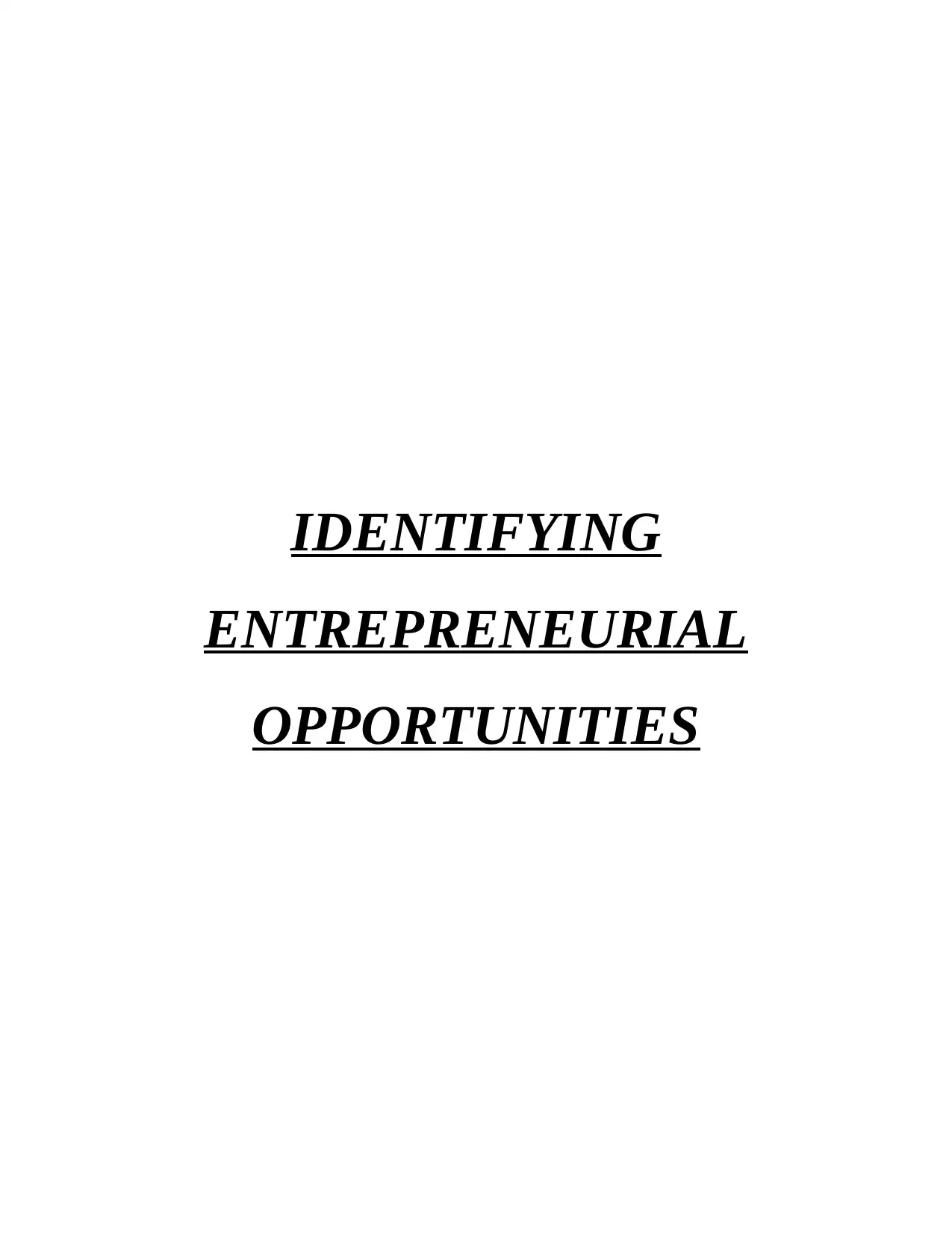
IDENTIFYING
ENTREPRENEURIAL
OPPORTUNITIES
ENTREPRENEURIAL
OPPORTUNITIES
Secure Best Marks with AI Grader
Need help grading? Try our AI Grader for instant feedback on your assignments.
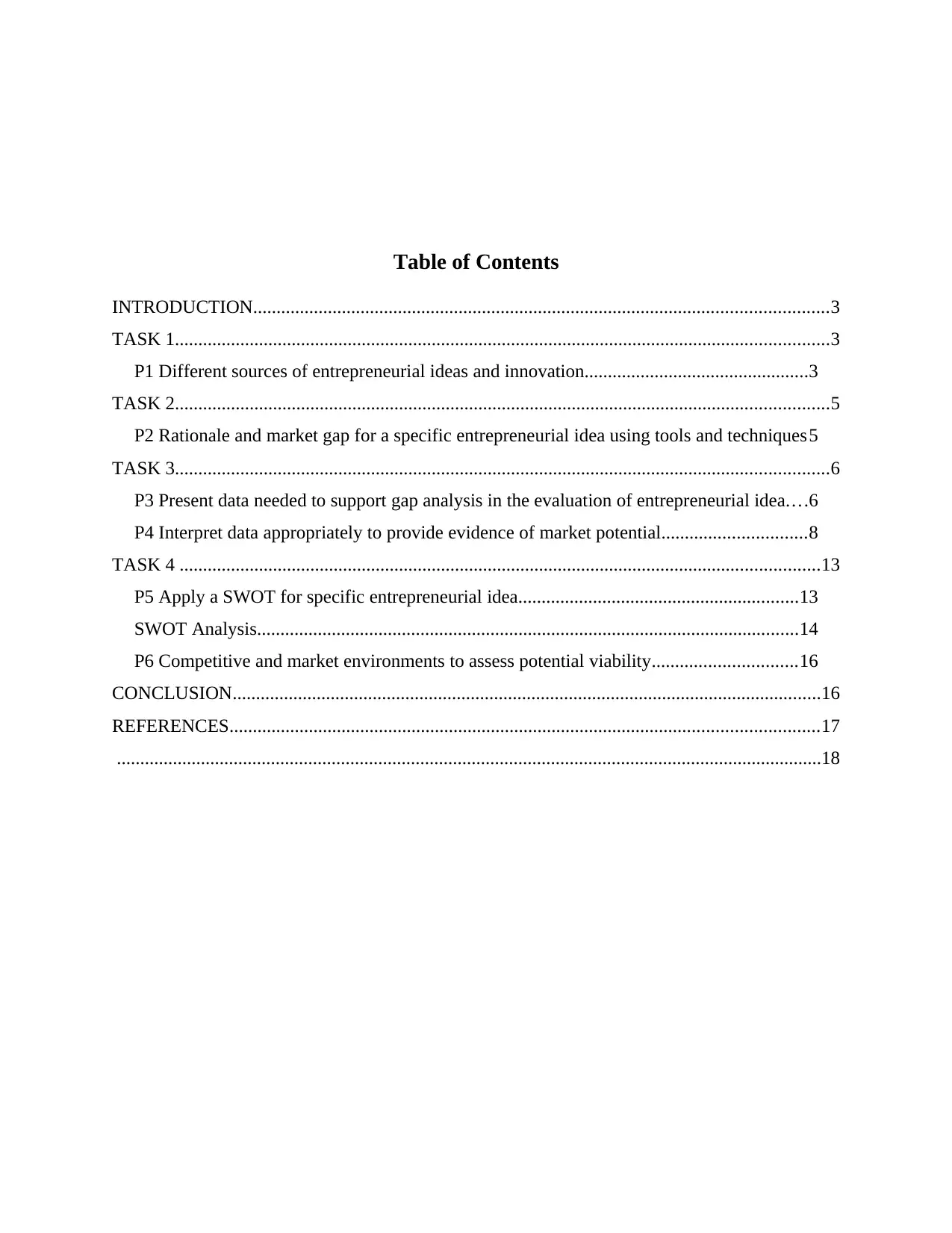
Table of Contents
INTRODUCTION...........................................................................................................................3
TASK 1............................................................................................................................................3
P1 Different sources of entrepreneurial ideas and innovation................................................3
TASK 2............................................................................................................................................5
P2 Rationale and market gap for a specific entrepreneurial idea using tools and techniques5
TASK 3............................................................................................................................................6
P3 Present data needed to support gap analysis in the evaluation of entrepreneurial idea....6
P4 Interpret data appropriately to provide evidence of market potential...............................8
TASK 4 .........................................................................................................................................13
P5 Apply a SWOT for specific entrepreneurial idea............................................................13
SWOT Analysis....................................................................................................................14
P6 Competitive and market environments to assess potential viability...............................16
CONCLUSION..............................................................................................................................16
REFERENCES..............................................................................................................................17
.......................................................................................................................................................18
INTRODUCTION...........................................................................................................................3
TASK 1............................................................................................................................................3
P1 Different sources of entrepreneurial ideas and innovation................................................3
TASK 2............................................................................................................................................5
P2 Rationale and market gap for a specific entrepreneurial idea using tools and techniques5
TASK 3............................................................................................................................................6
P3 Present data needed to support gap analysis in the evaluation of entrepreneurial idea....6
P4 Interpret data appropriately to provide evidence of market potential...............................8
TASK 4 .........................................................................................................................................13
P5 Apply a SWOT for specific entrepreneurial idea............................................................13
SWOT Analysis....................................................................................................................14
P6 Competitive and market environments to assess potential viability...............................16
CONCLUSION..............................................................................................................................16
REFERENCES..............................................................................................................................17
.......................................................................................................................................................18
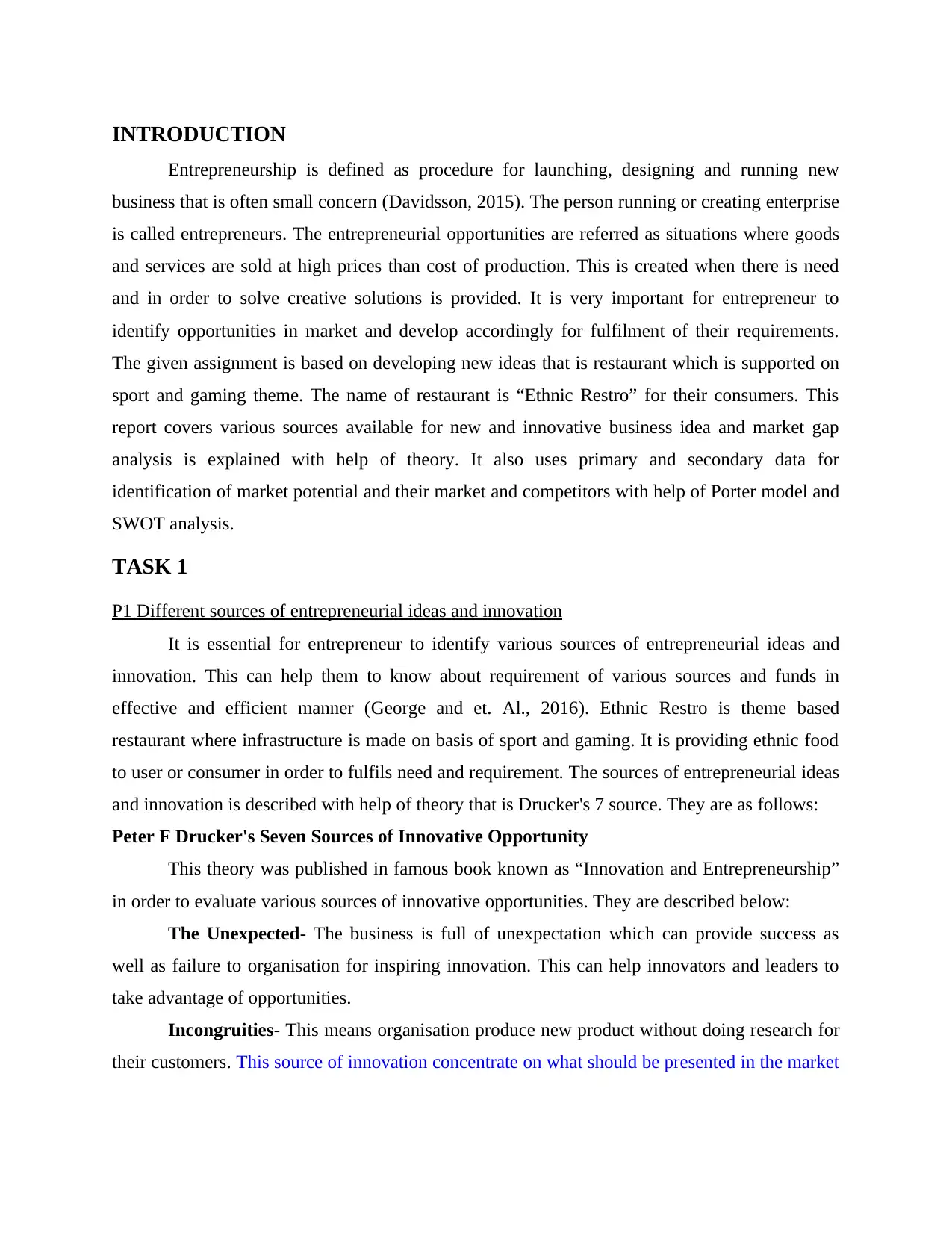
INTRODUCTION
Entrepreneurship is defined as procedure for launching, designing and running new
business that is often small concern (Davidsson, 2015). The person running or creating enterprise
is called entrepreneurs. The entrepreneurial opportunities are referred as situations where goods
and services are sold at high prices than cost of production. This is created when there is need
and in order to solve creative solutions is provided. It is very important for entrepreneur to
identify opportunities in market and develop accordingly for fulfilment of their requirements.
The given assignment is based on developing new ideas that is restaurant which is supported on
sport and gaming theme. The name of restaurant is “Ethnic Restro” for their consumers. This
report covers various sources available for new and innovative business idea and market gap
analysis is explained with help of theory. It also uses primary and secondary data for
identification of market potential and their market and competitors with help of Porter model and
SWOT analysis.
TASK 1
P1 Different sources of entrepreneurial ideas and innovation
It is essential for entrepreneur to identify various sources of entrepreneurial ideas and
innovation. This can help them to know about requirement of various sources and funds in
effective and efficient manner (George and et. Al., 2016). Ethnic Restro is theme based
restaurant where infrastructure is made on basis of sport and gaming. It is providing ethnic food
to user or consumer in order to fulfils need and requirement. The sources of entrepreneurial ideas
and innovation is described with help of theory that is Drucker's 7 source. They are as follows:
Peter F Drucker's Seven Sources of Innovative Opportunity
This theory was published in famous book known as “Innovation and Entrepreneurship”
in order to evaluate various sources of innovative opportunities. They are described below:
The Unexpected- The business is full of unexpectation which can provide success as
well as failure to organisation for inspiring innovation. This can help innovators and leaders to
take advantage of opportunities.
Incongruities- This means organisation produce new product without doing research for
their customers. This source of innovation concentrate on what should be presented in the market
Entrepreneurship is defined as procedure for launching, designing and running new
business that is often small concern (Davidsson, 2015). The person running or creating enterprise
is called entrepreneurs. The entrepreneurial opportunities are referred as situations where goods
and services are sold at high prices than cost of production. This is created when there is need
and in order to solve creative solutions is provided. It is very important for entrepreneur to
identify opportunities in market and develop accordingly for fulfilment of their requirements.
The given assignment is based on developing new ideas that is restaurant which is supported on
sport and gaming theme. The name of restaurant is “Ethnic Restro” for their consumers. This
report covers various sources available for new and innovative business idea and market gap
analysis is explained with help of theory. It also uses primary and secondary data for
identification of market potential and their market and competitors with help of Porter model and
SWOT analysis.
TASK 1
P1 Different sources of entrepreneurial ideas and innovation
It is essential for entrepreneur to identify various sources of entrepreneurial ideas and
innovation. This can help them to know about requirement of various sources and funds in
effective and efficient manner (George and et. Al., 2016). Ethnic Restro is theme based
restaurant where infrastructure is made on basis of sport and gaming. It is providing ethnic food
to user or consumer in order to fulfils need and requirement. The sources of entrepreneurial ideas
and innovation is described with help of theory that is Drucker's 7 source. They are as follows:
Peter F Drucker's Seven Sources of Innovative Opportunity
This theory was published in famous book known as “Innovation and Entrepreneurship”
in order to evaluate various sources of innovative opportunities. They are described below:
The Unexpected- The business is full of unexpectation which can provide success as
well as failure to organisation for inspiring innovation. This can help innovators and leaders to
take advantage of opportunities.
Incongruities- This means organisation produce new product without doing research for
their customers. This source of innovation concentrate on what should be presented in the market
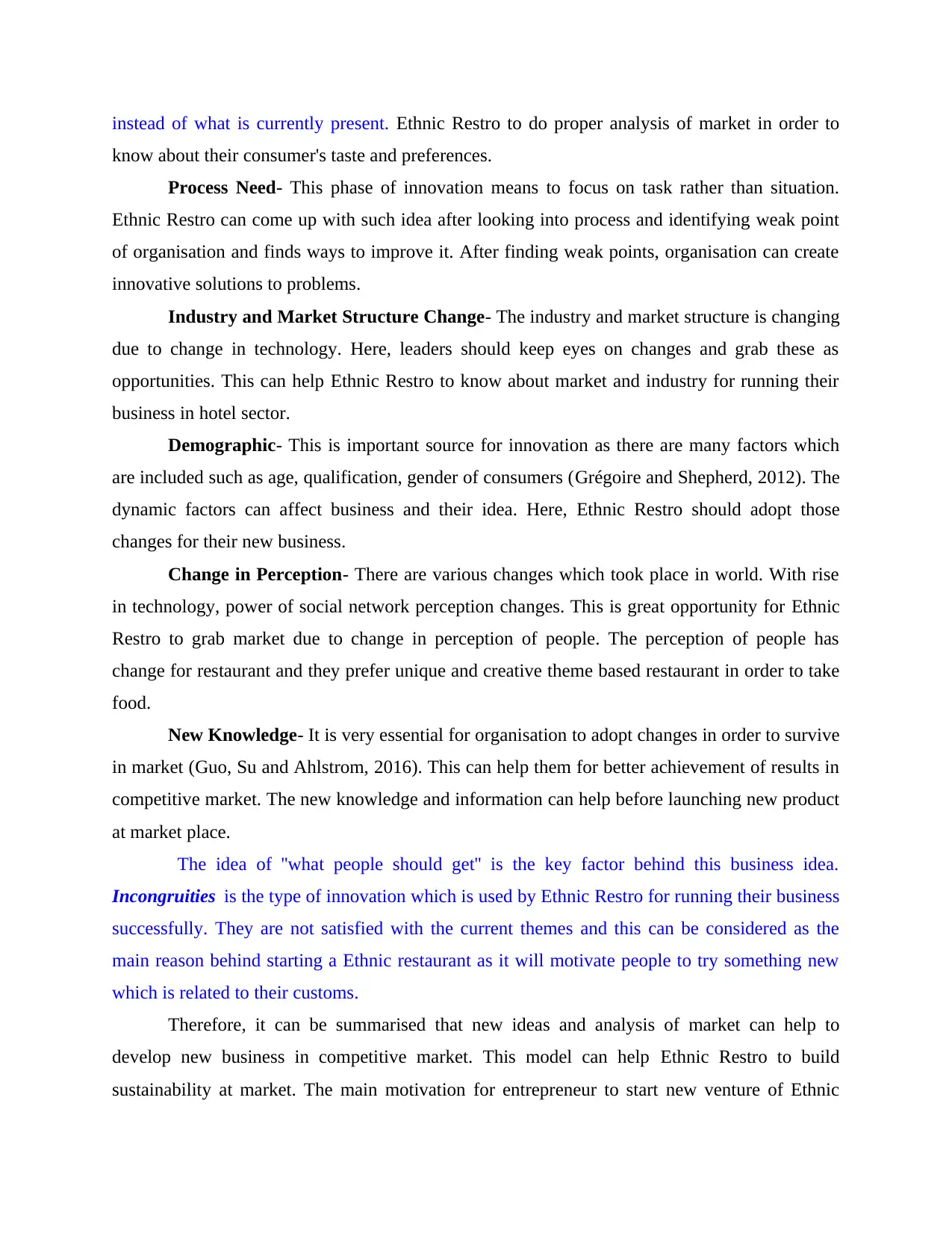
instead of what is currently present. Ethnic Restro to do proper analysis of market in order to
know about their consumer's taste and preferences.
Process Need- This phase of innovation means to focus on task rather than situation.
Ethnic Restro can come up with such idea after looking into process and identifying weak point
of organisation and finds ways to improve it. After finding weak points, organisation can create
innovative solutions to problems.
Industry and Market Structure Change- The industry and market structure is changing
due to change in technology. Here, leaders should keep eyes on changes and grab these as
opportunities. This can help Ethnic Restro to know about market and industry for running their
business in hotel sector.
Demographic- This is important source for innovation as there are many factors which
are included such as age, qualification, gender of consumers (Grégoire and Shepherd, 2012). The
dynamic factors can affect business and their idea. Here, Ethnic Restro should adopt those
changes for their new business.
Change in Perception- There are various changes which took place in world. With rise
in technology, power of social network perception changes. This is great opportunity for Ethnic
Restro to grab market due to change in perception of people. The perception of people has
change for restaurant and they prefer unique and creative theme based restaurant in order to take
food.
New Knowledge- It is very essential for organisation to adopt changes in order to survive
in market (Guo, Su and Ahlstrom, 2016). This can help them for better achievement of results in
competitive market. The new knowledge and information can help before launching new product
at market place.
The idea of ''what people should get'' is the key factor behind this business idea.
Incongruities is the type of innovation which is used by Ethnic Restro for running their business
successfully. They are not satisfied with the current themes and this can be considered as the
main reason behind starting a Ethnic restaurant as it will motivate people to try something new
which is related to their customs.
Therefore, it can be summarised that new ideas and analysis of market can help to
develop new business in competitive market. This model can help Ethnic Restro to build
sustainability at market. The main motivation for entrepreneur to start new venture of Ethnic
know about their consumer's taste and preferences.
Process Need- This phase of innovation means to focus on task rather than situation.
Ethnic Restro can come up with such idea after looking into process and identifying weak point
of organisation and finds ways to improve it. After finding weak points, organisation can create
innovative solutions to problems.
Industry and Market Structure Change- The industry and market structure is changing
due to change in technology. Here, leaders should keep eyes on changes and grab these as
opportunities. This can help Ethnic Restro to know about market and industry for running their
business in hotel sector.
Demographic- This is important source for innovation as there are many factors which
are included such as age, qualification, gender of consumers (Grégoire and Shepherd, 2012). The
dynamic factors can affect business and their idea. Here, Ethnic Restro should adopt those
changes for their new business.
Change in Perception- There are various changes which took place in world. With rise
in technology, power of social network perception changes. This is great opportunity for Ethnic
Restro to grab market due to change in perception of people. The perception of people has
change for restaurant and they prefer unique and creative theme based restaurant in order to take
food.
New Knowledge- It is very essential for organisation to adopt changes in order to survive
in market (Guo, Su and Ahlstrom, 2016). This can help them for better achievement of results in
competitive market. The new knowledge and information can help before launching new product
at market place.
The idea of ''what people should get'' is the key factor behind this business idea.
Incongruities is the type of innovation which is used by Ethnic Restro for running their business
successfully. They are not satisfied with the current themes and this can be considered as the
main reason behind starting a Ethnic restaurant as it will motivate people to try something new
which is related to their customs.
Therefore, it can be summarised that new ideas and analysis of market can help to
develop new business in competitive market. This model can help Ethnic Restro to build
sustainability at market. The main motivation for entrepreneur to start new venture of Ethnic
Secure Best Marks with AI Grader
Need help grading? Try our AI Grader for instant feedback on your assignments.
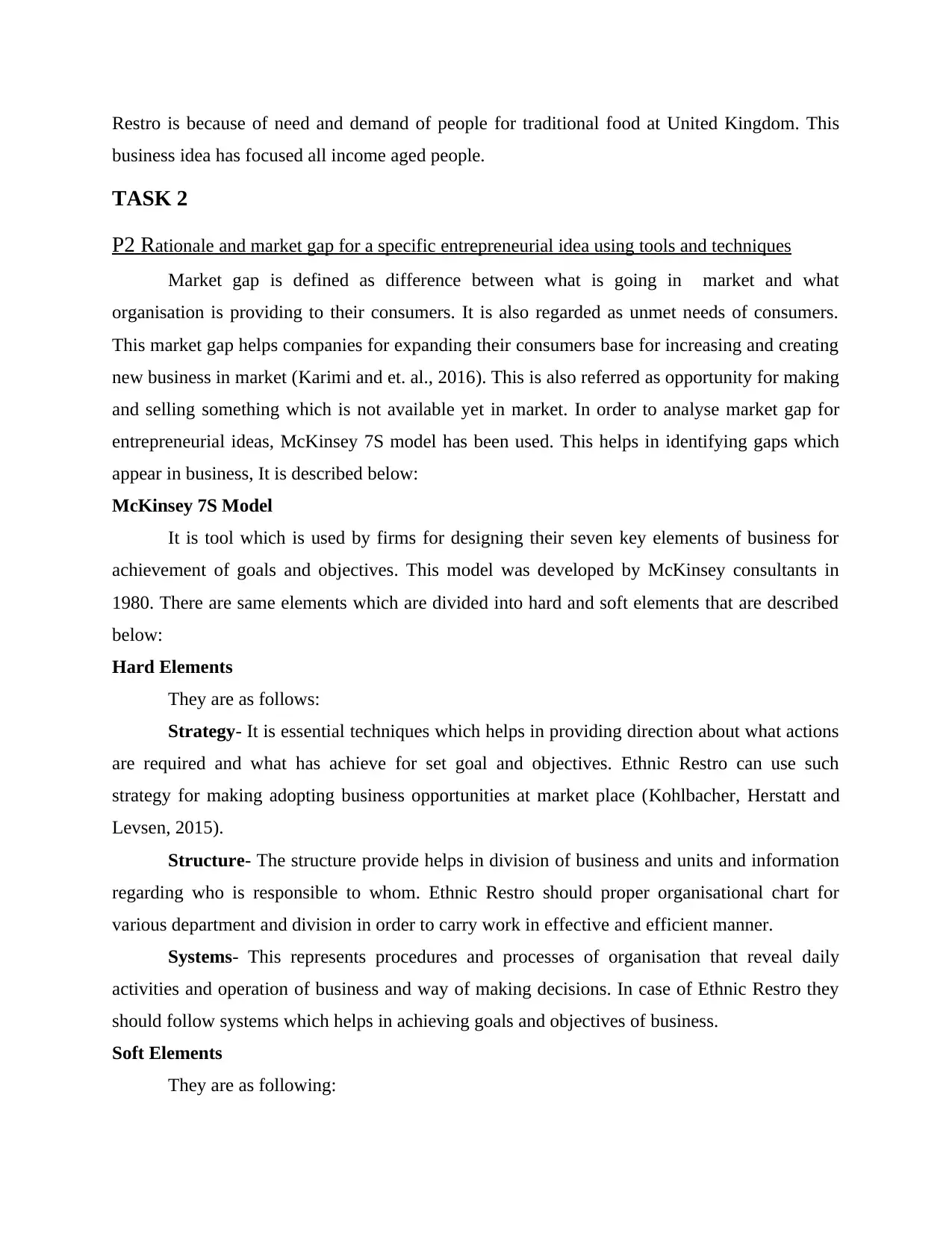
Restro is because of need and demand of people for traditional food at United Kingdom. This
business idea has focused all income aged people.
TASK 2
P2 Rationale and market gap for a specific entrepreneurial idea using tools and techniques
Market gap is defined as difference between what is going in market and what
organisation is providing to their consumers. It is also regarded as unmet needs of consumers.
This market gap helps companies for expanding their consumers base for increasing and creating
new business in market (Karimi and et. al., 2016). This is also referred as opportunity for making
and selling something which is not available yet in market. In order to analyse market gap for
entrepreneurial ideas, McKinsey 7S model has been used. This helps in identifying gaps which
appear in business, It is described below:
McKinsey 7S Model
It is tool which is used by firms for designing their seven key elements of business for
achievement of goals and objectives. This model was developed by McKinsey consultants in
1980. There are same elements which are divided into hard and soft elements that are described
below:
Hard Elements
They are as follows:
Strategy- It is essential techniques which helps in providing direction about what actions
are required and what has achieve for set goal and objectives. Ethnic Restro can use such
strategy for making adopting business opportunities at market place (Kohlbacher, Herstatt and
Levsen, 2015).
Structure- The structure provide helps in division of business and units and information
regarding who is responsible to whom. Ethnic Restro should proper organisational chart for
various department and division in order to carry work in effective and efficient manner.
Systems- This represents procedures and processes of organisation that reveal daily
activities and operation of business and way of making decisions. In case of Ethnic Restro they
should follow systems which helps in achieving goals and objectives of business.
Soft Elements
They are as following:
business idea has focused all income aged people.
TASK 2
P2 Rationale and market gap for a specific entrepreneurial idea using tools and techniques
Market gap is defined as difference between what is going in market and what
organisation is providing to their consumers. It is also regarded as unmet needs of consumers.
This market gap helps companies for expanding their consumers base for increasing and creating
new business in market (Karimi and et. al., 2016). This is also referred as opportunity for making
and selling something which is not available yet in market. In order to analyse market gap for
entrepreneurial ideas, McKinsey 7S model has been used. This helps in identifying gaps which
appear in business, It is described below:
McKinsey 7S Model
It is tool which is used by firms for designing their seven key elements of business for
achievement of goals and objectives. This model was developed by McKinsey consultants in
1980. There are same elements which are divided into hard and soft elements that are described
below:
Hard Elements
They are as follows:
Strategy- It is essential techniques which helps in providing direction about what actions
are required and what has achieve for set goal and objectives. Ethnic Restro can use such
strategy for making adopting business opportunities at market place (Kohlbacher, Herstatt and
Levsen, 2015).
Structure- The structure provide helps in division of business and units and information
regarding who is responsible to whom. Ethnic Restro should proper organisational chart for
various department and division in order to carry work in effective and efficient manner.
Systems- This represents procedures and processes of organisation that reveal daily
activities and operation of business and way of making decisions. In case of Ethnic Restro they
should follow systems which helps in achieving goals and objectives of business.
Soft Elements
They are as following:
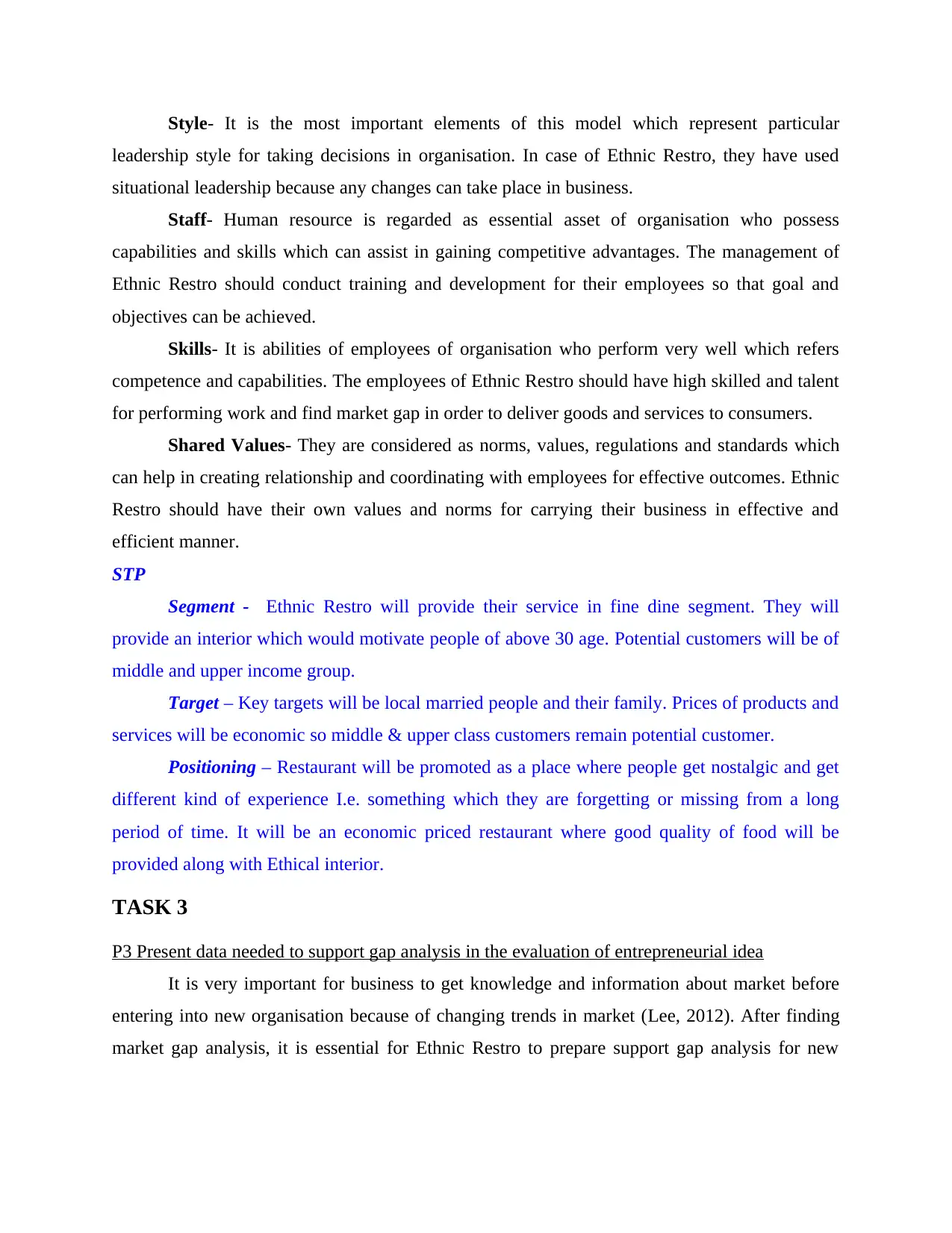
Style- It is the most important elements of this model which represent particular
leadership style for taking decisions in organisation. In case of Ethnic Restro, they have used
situational leadership because any changes can take place in business.
Staff- Human resource is regarded as essential asset of organisation who possess
capabilities and skills which can assist in gaining competitive advantages. The management of
Ethnic Restro should conduct training and development for their employees so that goal and
objectives can be achieved.
Skills- It is abilities of employees of organisation who perform very well which refers
competence and capabilities. The employees of Ethnic Restro should have high skilled and talent
for performing work and find market gap in order to deliver goods and services to consumers.
Shared Values- They are considered as norms, values, regulations and standards which
can help in creating relationship and coordinating with employees for effective outcomes. Ethnic
Restro should have their own values and norms for carrying their business in effective and
efficient manner.
STP
Segment - Ethnic Restro will provide their service in fine dine segment. They will
provide an interior which would motivate people of above 30 age. Potential customers will be of
middle and upper income group.
Target – Key targets will be local married people and their family. Prices of products and
services will be economic so middle & upper class customers remain potential customer.
Positioning – Restaurant will be promoted as a place where people get nostalgic and get
different kind of experience I.e. something which they are forgetting or missing from a long
period of time. It will be an economic priced restaurant where good quality of food will be
provided along with Ethical interior.
TASK 3
P3 Present data needed to support gap analysis in the evaluation of entrepreneurial idea
It is very important for business to get knowledge and information about market before
entering into new organisation because of changing trends in market (Lee, 2012). After finding
market gap analysis, it is essential for Ethnic Restro to prepare support gap analysis for new
leadership style for taking decisions in organisation. In case of Ethnic Restro, they have used
situational leadership because any changes can take place in business.
Staff- Human resource is regarded as essential asset of organisation who possess
capabilities and skills which can assist in gaining competitive advantages. The management of
Ethnic Restro should conduct training and development for their employees so that goal and
objectives can be achieved.
Skills- It is abilities of employees of organisation who perform very well which refers
competence and capabilities. The employees of Ethnic Restro should have high skilled and talent
for performing work and find market gap in order to deliver goods and services to consumers.
Shared Values- They are considered as norms, values, regulations and standards which
can help in creating relationship and coordinating with employees for effective outcomes. Ethnic
Restro should have their own values and norms for carrying their business in effective and
efficient manner.
STP
Segment - Ethnic Restro will provide their service in fine dine segment. They will
provide an interior which would motivate people of above 30 age. Potential customers will be of
middle and upper income group.
Target – Key targets will be local married people and their family. Prices of products and
services will be economic so middle & upper class customers remain potential customer.
Positioning – Restaurant will be promoted as a place where people get nostalgic and get
different kind of experience I.e. something which they are forgetting or missing from a long
period of time. It will be an economic priced restaurant where good quality of food will be
provided along with Ethical interior.
TASK 3
P3 Present data needed to support gap analysis in the evaluation of entrepreneurial idea
It is very important for business to get knowledge and information about market before
entering into new organisation because of changing trends in market (Lee, 2012). After finding
market gap analysis, it is essential for Ethnic Restro to prepare support gap analysis for new
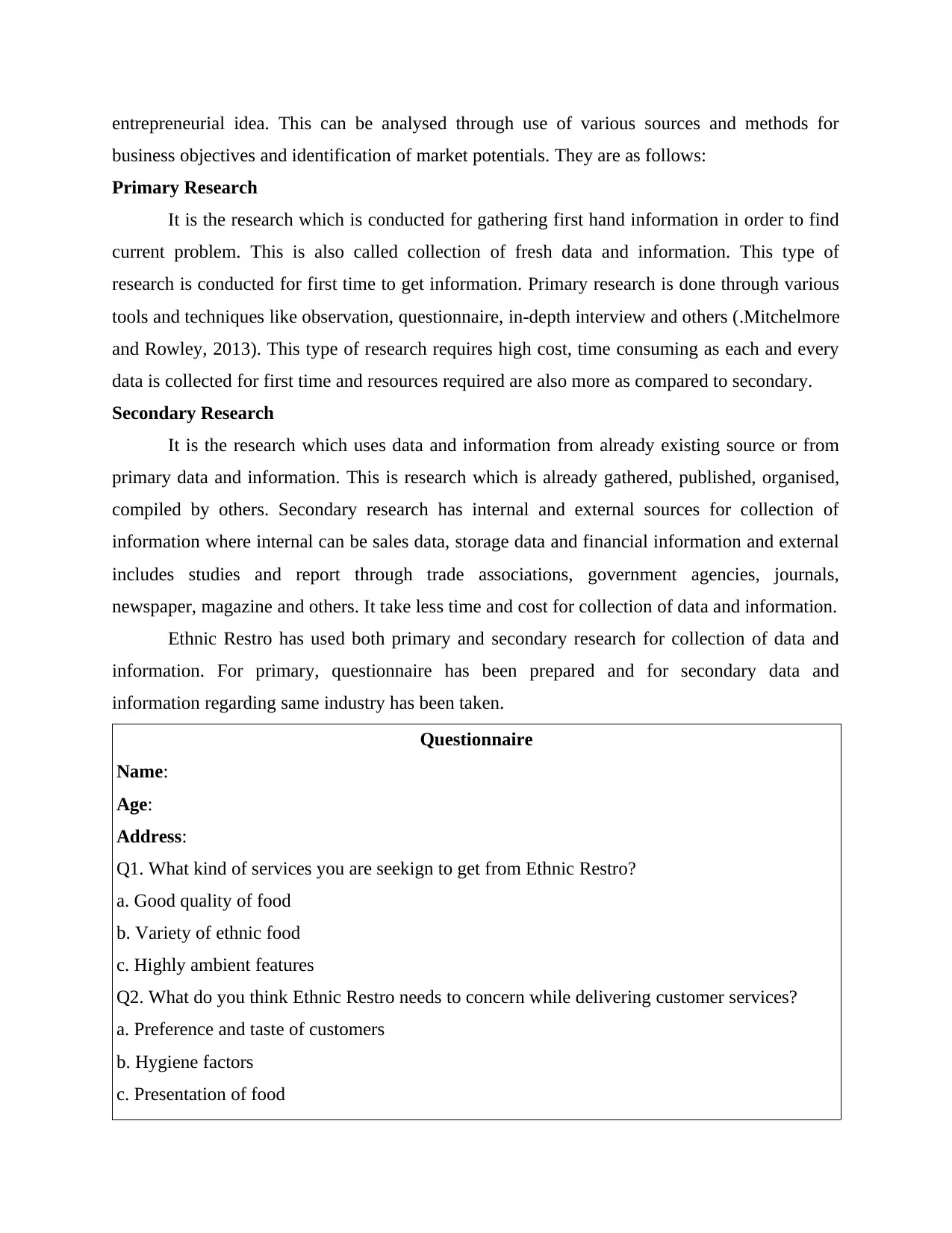
entrepreneurial idea. This can be analysed through use of various sources and methods for
business objectives and identification of market potentials. They are as follows:
Primary Research
It is the research which is conducted for gathering first hand information in order to find
current problem. This is also called collection of fresh data and information. This type of
research is conducted for first time to get information. Primary research is done through various
tools and techniques like observation, questionnaire, in-depth interview and others (.Mitchelmore
and Rowley, 2013). This type of research requires high cost, time consuming as each and every
data is collected for first time and resources required are also more as compared to secondary.
Secondary Research
It is the research which uses data and information from already existing source or from
primary data and information. This is research which is already gathered, published, organised,
compiled by others. Secondary research has internal and external sources for collection of
information where internal can be sales data, storage data and financial information and external
includes studies and report through trade associations, government agencies, journals,
newspaper, magazine and others. It take less time and cost for collection of data and information.
Ethnic Restro has used both primary and secondary research for collection of data and
information. For primary, questionnaire has been prepared and for secondary data and
information regarding same industry has been taken.
Questionnaire
Name:
Age:
Address:
Q1. What kind of services you are seekign to get from Ethnic Restro?
a. Good quality of food
b. Variety of ethnic food
c. Highly ambient features
Q2. What do you think Ethnic Restro needs to concern while delivering customer services?
a. Preference and taste of customers
b. Hygiene factors
c. Presentation of food
business objectives and identification of market potentials. They are as follows:
Primary Research
It is the research which is conducted for gathering first hand information in order to find
current problem. This is also called collection of fresh data and information. This type of
research is conducted for first time to get information. Primary research is done through various
tools and techniques like observation, questionnaire, in-depth interview and others (.Mitchelmore
and Rowley, 2013). This type of research requires high cost, time consuming as each and every
data is collected for first time and resources required are also more as compared to secondary.
Secondary Research
It is the research which uses data and information from already existing source or from
primary data and information. This is research which is already gathered, published, organised,
compiled by others. Secondary research has internal and external sources for collection of
information where internal can be sales data, storage data and financial information and external
includes studies and report through trade associations, government agencies, journals,
newspaper, magazine and others. It take less time and cost for collection of data and information.
Ethnic Restro has used both primary and secondary research for collection of data and
information. For primary, questionnaire has been prepared and for secondary data and
information regarding same industry has been taken.
Questionnaire
Name:
Age:
Address:
Q1. What kind of services you are seekign to get from Ethnic Restro?
a. Good quality of food
b. Variety of ethnic food
c. Highly ambient features
Q2. What do you think Ethnic Restro needs to concern while delivering customer services?
a. Preference and taste of customers
b. Hygiene factors
c. Presentation of food
Paraphrase This Document
Need a fresh take? Get an instant paraphrase of this document with our AI Paraphraser
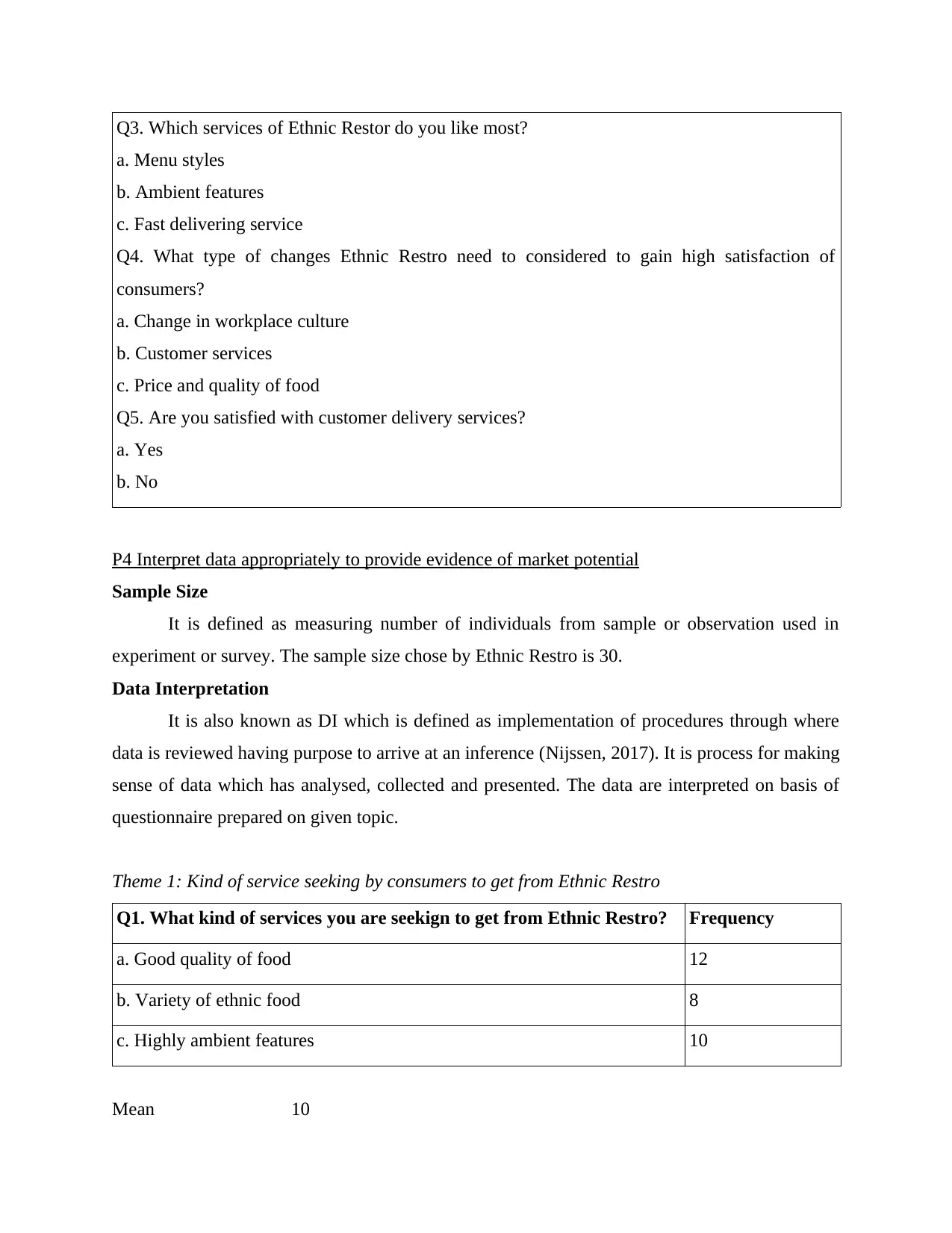
Q3. Which services of Ethnic Restor do you like most?
a. Menu styles
b. Ambient features
c. Fast delivering service
Q4. What type of changes Ethnic Restro need to considered to gain high satisfaction of
consumers?
a. Change in workplace culture
b. Customer services
c. Price and quality of food
Q5. Are you satisfied with customer delivery services?
a. Yes
b. No
P4 Interpret data appropriately to provide evidence of market potential
Sample Size
It is defined as measuring number of individuals from sample or observation used in
experiment or survey. The sample size chose by Ethnic Restro is 30.
Data Interpretation
It is also known as DI which is defined as implementation of procedures through where
data is reviewed having purpose to arrive at an inference (Nijssen, 2017). It is process for making
sense of data which has analysed, collected and presented. The data are interpreted on basis of
questionnaire prepared on given topic.
Theme 1: Kind of service seeking by consumers to get from Ethnic Restro
Q1. What kind of services you are seekign to get from Ethnic Restro? Frequency
a. Good quality of food 12
b. Variety of ethnic food 8
c. Highly ambient features 10
Mean 10
a. Menu styles
b. Ambient features
c. Fast delivering service
Q4. What type of changes Ethnic Restro need to considered to gain high satisfaction of
consumers?
a. Change in workplace culture
b. Customer services
c. Price and quality of food
Q5. Are you satisfied with customer delivery services?
a. Yes
b. No
P4 Interpret data appropriately to provide evidence of market potential
Sample Size
It is defined as measuring number of individuals from sample or observation used in
experiment or survey. The sample size chose by Ethnic Restro is 30.
Data Interpretation
It is also known as DI which is defined as implementation of procedures through where
data is reviewed having purpose to arrive at an inference (Nijssen, 2017). It is process for making
sense of data which has analysed, collected and presented. The data are interpreted on basis of
questionnaire prepared on given topic.
Theme 1: Kind of service seeking by consumers to get from Ethnic Restro
Q1. What kind of services you are seekign to get from Ethnic Restro? Frequency
a. Good quality of food 12
b. Variety of ethnic food 8
c. Highly ambient features 10
Mean 10
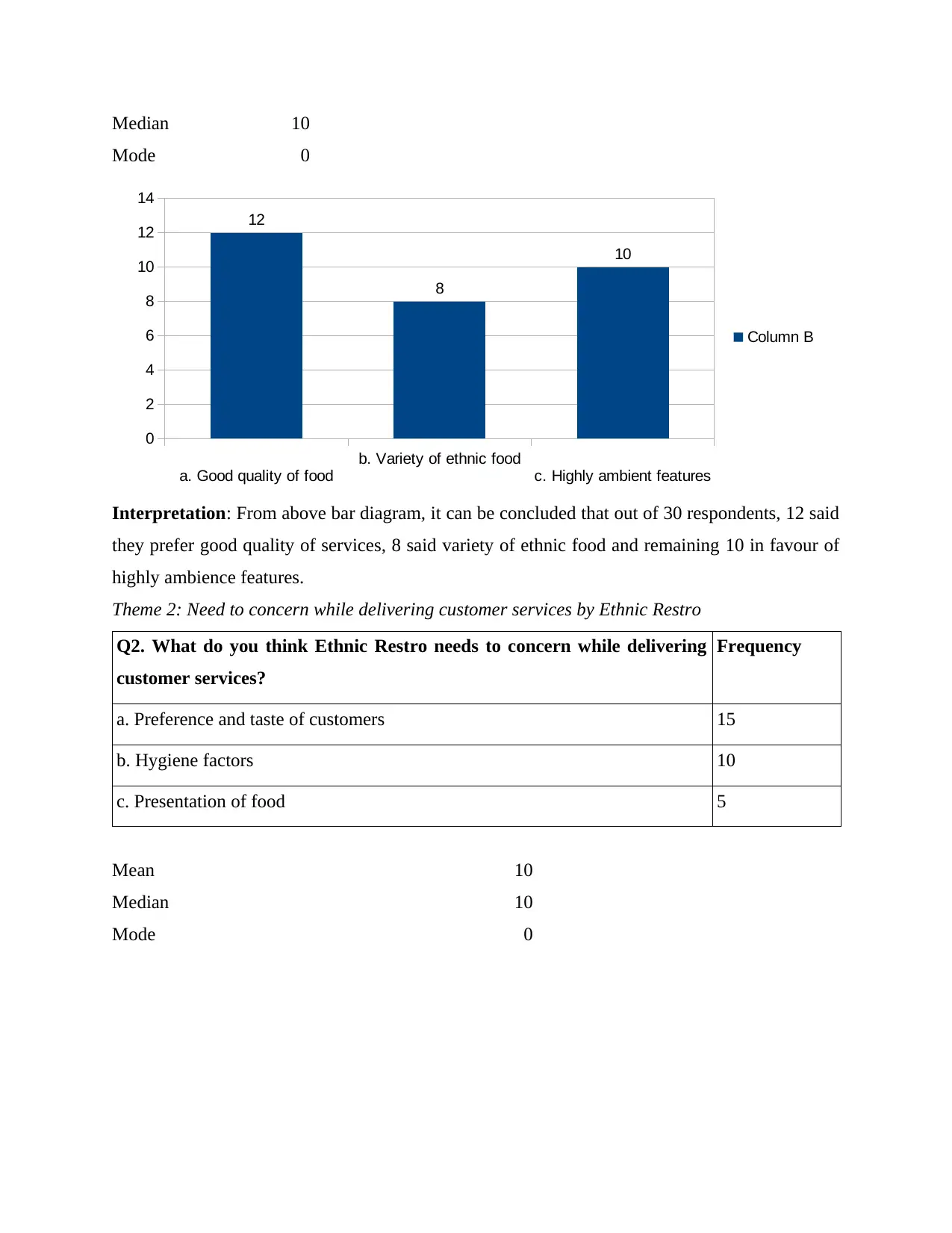
Median 10
Mode 0
Interpretation: From above bar diagram, it can be concluded that out of 30 respondents, 12 said
they prefer good quality of services, 8 said variety of ethnic food and remaining 10 in favour of
highly ambience features.
Theme 2: Need to concern while delivering customer services by Ethnic Restro
Q2. What do you think Ethnic Restro needs to concern while delivering
customer services?
Frequency
a. Preference and taste of customers 15
b. Hygiene factors 10
c. Presentation of food 5
Mean 10
Median 10
Mode 0
a. Good quality of food
b. Variety of ethnic food
c. Highly ambient features
0
2
4
6
8
10
12
14
12
8
10
Column B
Mode 0
Interpretation: From above bar diagram, it can be concluded that out of 30 respondents, 12 said
they prefer good quality of services, 8 said variety of ethnic food and remaining 10 in favour of
highly ambience features.
Theme 2: Need to concern while delivering customer services by Ethnic Restro
Q2. What do you think Ethnic Restro needs to concern while delivering
customer services?
Frequency
a. Preference and taste of customers 15
b. Hygiene factors 10
c. Presentation of food 5
Mean 10
Median 10
Mode 0
a. Good quality of food
b. Variety of ethnic food
c. Highly ambient features
0
2
4
6
8
10
12
14
12
8
10
Column B
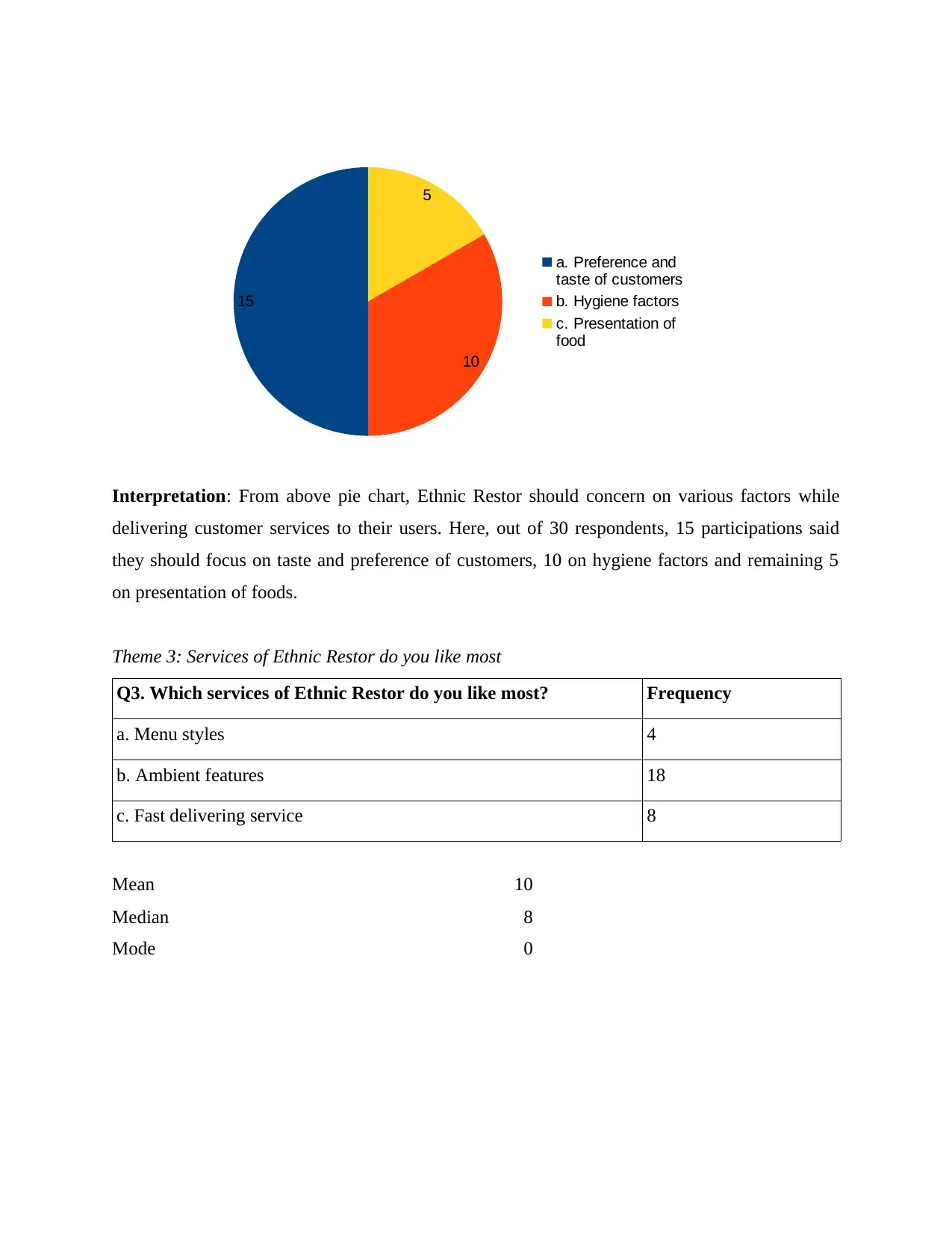
Interpretation: From above pie chart, Ethnic Restor should concern on various factors while
delivering customer services to their users. Here, out of 30 respondents, 15 participations said
they should focus on taste and preference of customers, 10 on hygiene factors and remaining 5
on presentation of foods.
Theme 3: Services of Ethnic Restor do you like most
Q3. Which services of Ethnic Restor do you like most? Frequency
a. Menu styles 4
b. Ambient features 18
c. Fast delivering service 8
Mean 10
Median 8
Mode 0
15
10
5
a. Preference and
taste of customers
b. Hygiene factors
c. Presentation of
food
delivering customer services to their users. Here, out of 30 respondents, 15 participations said
they should focus on taste and preference of customers, 10 on hygiene factors and remaining 5
on presentation of foods.
Theme 3: Services of Ethnic Restor do you like most
Q3. Which services of Ethnic Restor do you like most? Frequency
a. Menu styles 4
b. Ambient features 18
c. Fast delivering service 8
Mean 10
Median 8
Mode 0
15
10
5
a. Preference and
taste of customers
b. Hygiene factors
c. Presentation of
food
Secure Best Marks with AI Grader
Need help grading? Try our AI Grader for instant feedback on your assignments.
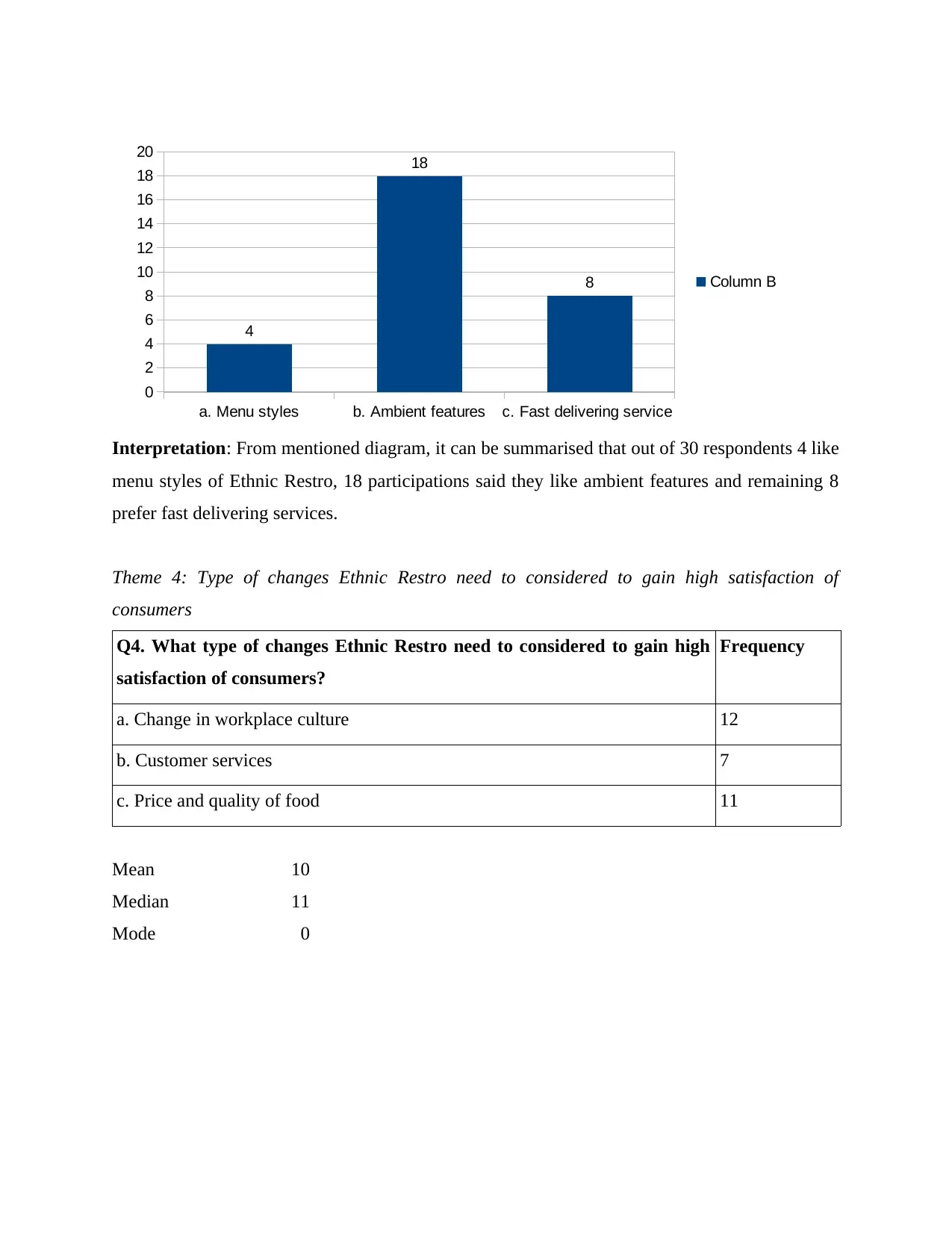
Interpretation: From mentioned diagram, it can be summarised that out of 30 respondents 4 like
menu styles of Ethnic Restro, 18 participations said they like ambient features and remaining 8
prefer fast delivering services.
Theme 4: Type of changes Ethnic Restro need to considered to gain high satisfaction of
consumers
Q4. What type of changes Ethnic Restro need to considered to gain high
satisfaction of consumers?
Frequency
a. Change in workplace culture 12
b. Customer services 7
c. Price and quality of food 11
Mean 10
Median 11
Mode 0
a. Menu styles b. Ambient features c. Fast delivering service
0
2
4
6
8
10
12
14
16
18
20
4
18
8 Column B
menu styles of Ethnic Restro, 18 participations said they like ambient features and remaining 8
prefer fast delivering services.
Theme 4: Type of changes Ethnic Restro need to considered to gain high satisfaction of
consumers
Q4. What type of changes Ethnic Restro need to considered to gain high
satisfaction of consumers?
Frequency
a. Change in workplace culture 12
b. Customer services 7
c. Price and quality of food 11
Mean 10
Median 11
Mode 0
a. Menu styles b. Ambient features c. Fast delivering service
0
2
4
6
8
10
12
14
16
18
20
4
18
8 Column B
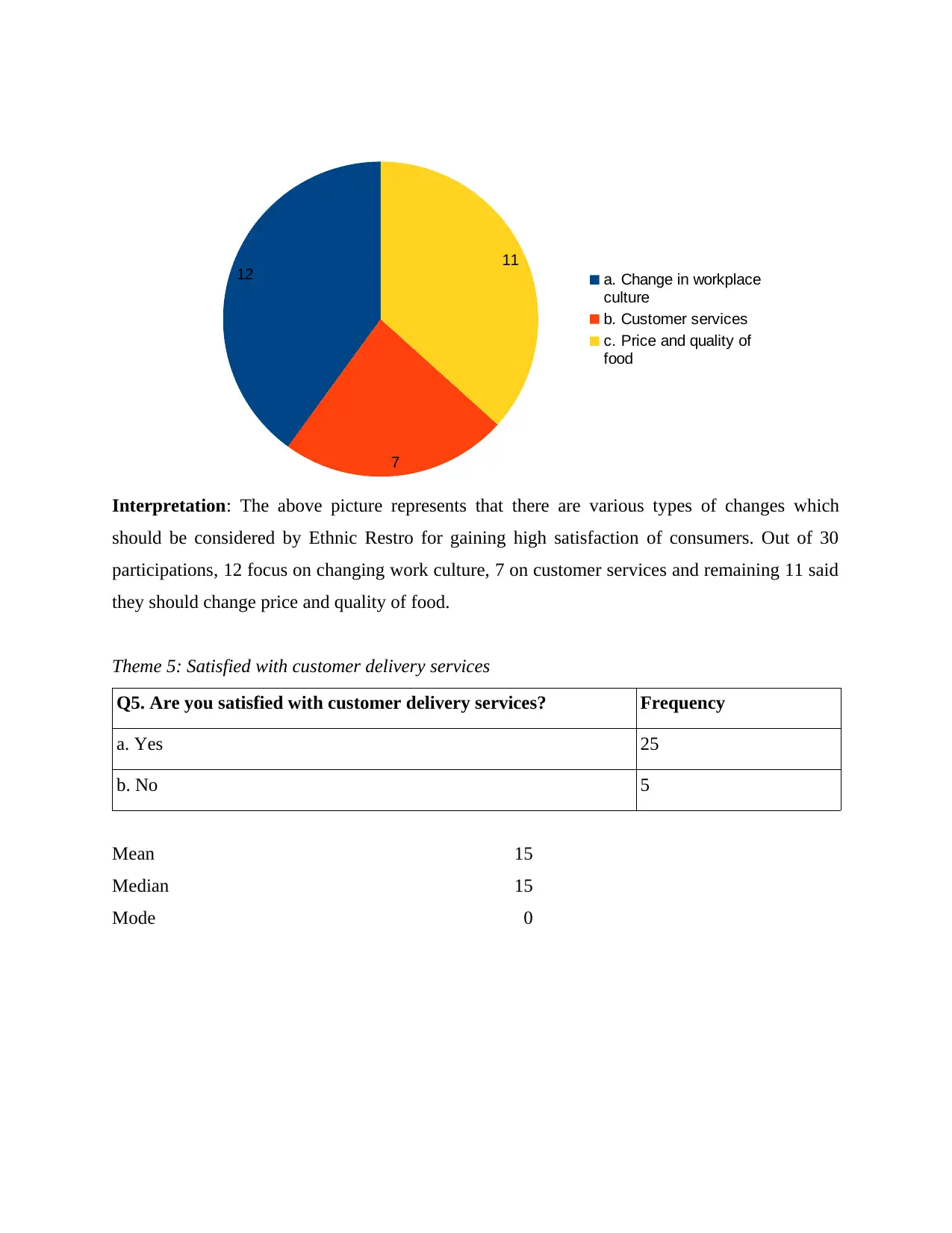
Interpretation: The above picture represents that there are various types of changes which
should be considered by Ethnic Restro for gaining high satisfaction of consumers. Out of 30
participations, 12 focus on changing work culture, 7 on customer services and remaining 11 said
they should change price and quality of food.
Theme 5: Satisfied with customer delivery services
Q5. Are you satisfied with customer delivery services? Frequency
a. Yes 25
b. No 5
Mean 15
Median 15
Mode 0
12
7
11
a. Change in workplace
culture
b. Customer services
c. Price and quality of
food
should be considered by Ethnic Restro for gaining high satisfaction of consumers. Out of 30
participations, 12 focus on changing work culture, 7 on customer services and remaining 11 said
they should change price and quality of food.
Theme 5: Satisfied with customer delivery services
Q5. Are you satisfied with customer delivery services? Frequency
a. Yes 25
b. No 5
Mean 15
Median 15
Mode 0
12
7
11
a. Change in workplace
culture
b. Customer services
c. Price and quality of
food
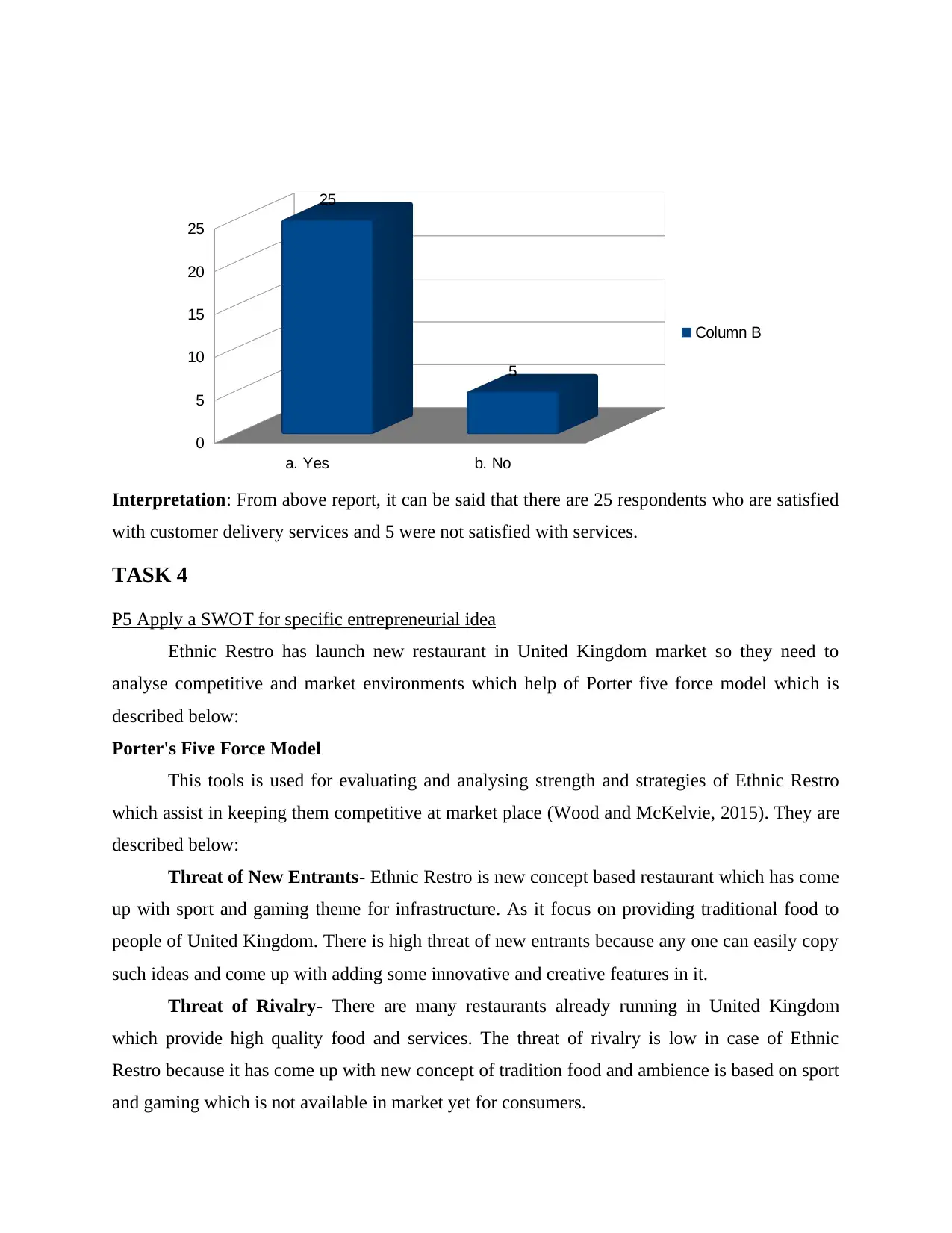
Interpretation: From above report, it can be said that there are 25 respondents who are satisfied
with customer delivery services and 5 were not satisfied with services.
TASK 4
P5 Apply a SWOT for specific entrepreneurial idea
Ethnic Restro has launch new restaurant in United Kingdom market so they need to
analyse competitive and market environments which help of Porter five force model which is
described below:
Porter's Five Force Model
This tools is used for evaluating and analysing strength and strategies of Ethnic Restro
which assist in keeping them competitive at market place (Wood and McKelvie, 2015). They are
described below:
Threat of New Entrants- Ethnic Restro is new concept based restaurant which has come
up with sport and gaming theme for infrastructure. As it focus on providing traditional food to
people of United Kingdom. There is high threat of new entrants because any one can easily copy
such ideas and come up with adding some innovative and creative features in it.
Threat of Rivalry- There are many restaurants already running in United Kingdom
which provide high quality food and services. The threat of rivalry is low in case of Ethnic
Restro because it has come up with new concept of tradition food and ambience is based on sport
and gaming which is not available in market yet for consumers.
a. Yes b. No
0
5
10
15
20
25
25
5
Column B
with customer delivery services and 5 were not satisfied with services.
TASK 4
P5 Apply a SWOT for specific entrepreneurial idea
Ethnic Restro has launch new restaurant in United Kingdom market so they need to
analyse competitive and market environments which help of Porter five force model which is
described below:
Porter's Five Force Model
This tools is used for evaluating and analysing strength and strategies of Ethnic Restro
which assist in keeping them competitive at market place (Wood and McKelvie, 2015). They are
described below:
Threat of New Entrants- Ethnic Restro is new concept based restaurant which has come
up with sport and gaming theme for infrastructure. As it focus on providing traditional food to
people of United Kingdom. There is high threat of new entrants because any one can easily copy
such ideas and come up with adding some innovative and creative features in it.
Threat of Rivalry- There are many restaurants already running in United Kingdom
which provide high quality food and services. The threat of rivalry is low in case of Ethnic
Restro because it has come up with new concept of tradition food and ambience is based on sport
and gaming which is not available in market yet for consumers.
a. Yes b. No
0
5
10
15
20
25
25
5
Column B
Paraphrase This Document
Need a fresh take? Get an instant paraphrase of this document with our AI Paraphraser
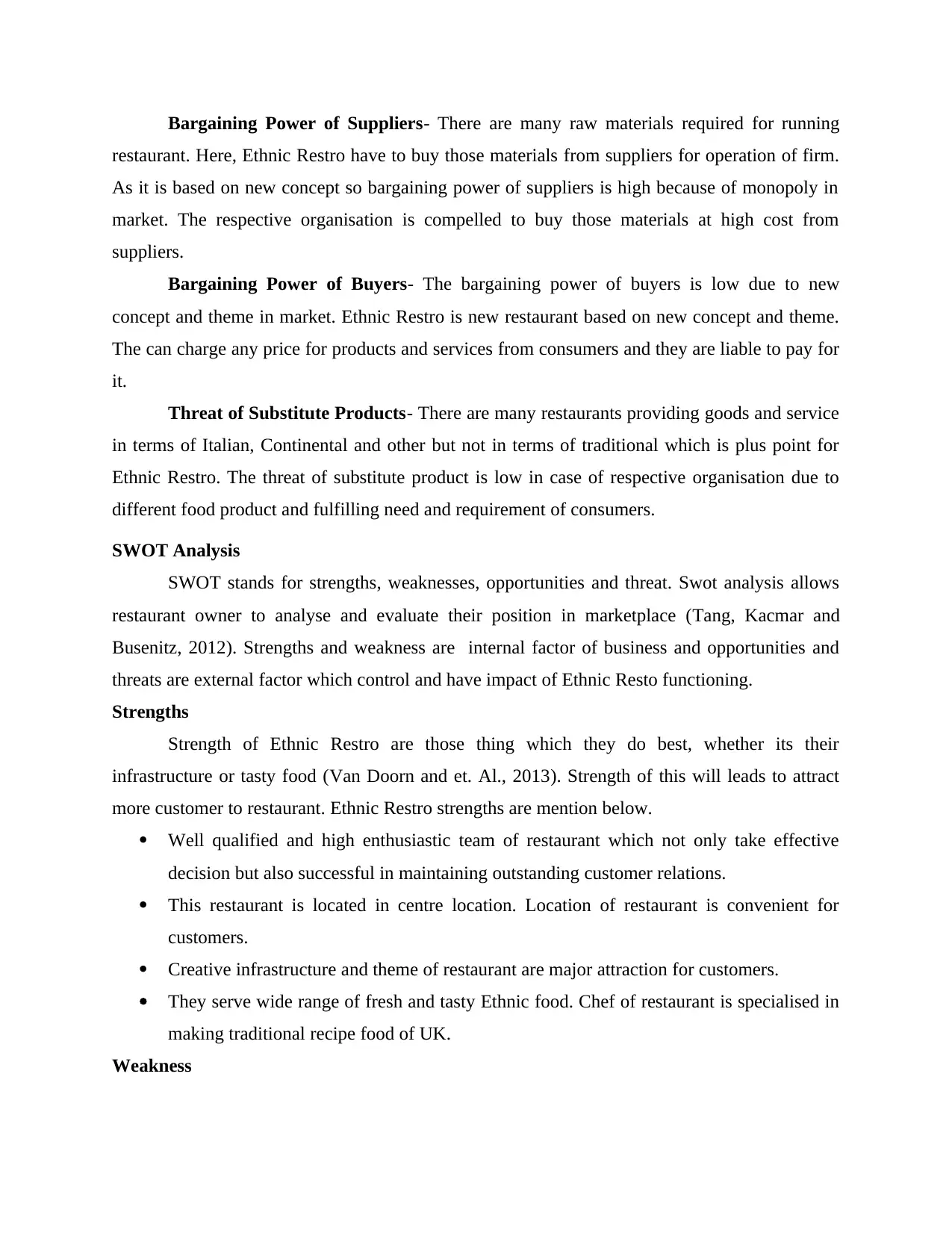
Bargaining Power of Suppliers- There are many raw materials required for running
restaurant. Here, Ethnic Restro have to buy those materials from suppliers for operation of firm.
As it is based on new concept so bargaining power of suppliers is high because of monopoly in
market. The respective organisation is compelled to buy those materials at high cost from
suppliers.
Bargaining Power of Buyers- The bargaining power of buyers is low due to new
concept and theme in market. Ethnic Restro is new restaurant based on new concept and theme.
The can charge any price for products and services from consumers and they are liable to pay for
it.
Threat of Substitute Products- There are many restaurants providing goods and service
in terms of Italian, Continental and other but not in terms of traditional which is plus point for
Ethnic Restro. The threat of substitute product is low in case of respective organisation due to
different food product and fulfilling need and requirement of consumers.
SWOT Analysis
SWOT stands for strengths, weaknesses, opportunities and threat. Swot analysis allows
restaurant owner to analyse and evaluate their position in marketplace (Tang, Kacmar and
Busenitz, 2012). Strengths and weakness are internal factor of business and opportunities and
threats are external factor which control and have impact of Ethnic Resto functioning.
Strengths
Strength of Ethnic Restro are those thing which they do best, whether its their
infrastructure or tasty food (Van Doorn and et. Al., 2013). Strength of this will leads to attract
more customer to restaurant. Ethnic Restro strengths are mention below.
Well qualified and high enthusiastic team of restaurant which not only take effective
decision but also successful in maintaining outstanding customer relations.
This restaurant is located in centre location. Location of restaurant is convenient for
customers.
Creative infrastructure and theme of restaurant are major attraction for customers.
They serve wide range of fresh and tasty Ethnic food. Chef of restaurant is specialised in
making traditional recipe food of UK.
Weakness
restaurant. Here, Ethnic Restro have to buy those materials from suppliers for operation of firm.
As it is based on new concept so bargaining power of suppliers is high because of monopoly in
market. The respective organisation is compelled to buy those materials at high cost from
suppliers.
Bargaining Power of Buyers- The bargaining power of buyers is low due to new
concept and theme in market. Ethnic Restro is new restaurant based on new concept and theme.
The can charge any price for products and services from consumers and they are liable to pay for
it.
Threat of Substitute Products- There are many restaurants providing goods and service
in terms of Italian, Continental and other but not in terms of traditional which is plus point for
Ethnic Restro. The threat of substitute product is low in case of respective organisation due to
different food product and fulfilling need and requirement of consumers.
SWOT Analysis
SWOT stands for strengths, weaknesses, opportunities and threat. Swot analysis allows
restaurant owner to analyse and evaluate their position in marketplace (Tang, Kacmar and
Busenitz, 2012). Strengths and weakness are internal factor of business and opportunities and
threats are external factor which control and have impact of Ethnic Resto functioning.
Strengths
Strength of Ethnic Restro are those thing which they do best, whether its their
infrastructure or tasty food (Van Doorn and et. Al., 2013). Strength of this will leads to attract
more customer to restaurant. Ethnic Restro strengths are mention below.
Well qualified and high enthusiastic team of restaurant which not only take effective
decision but also successful in maintaining outstanding customer relations.
This restaurant is located in centre location. Location of restaurant is convenient for
customers.
Creative infrastructure and theme of restaurant are major attraction for customers.
They serve wide range of fresh and tasty Ethnic food. Chef of restaurant is specialised in
making traditional recipe food of UK.
Weakness
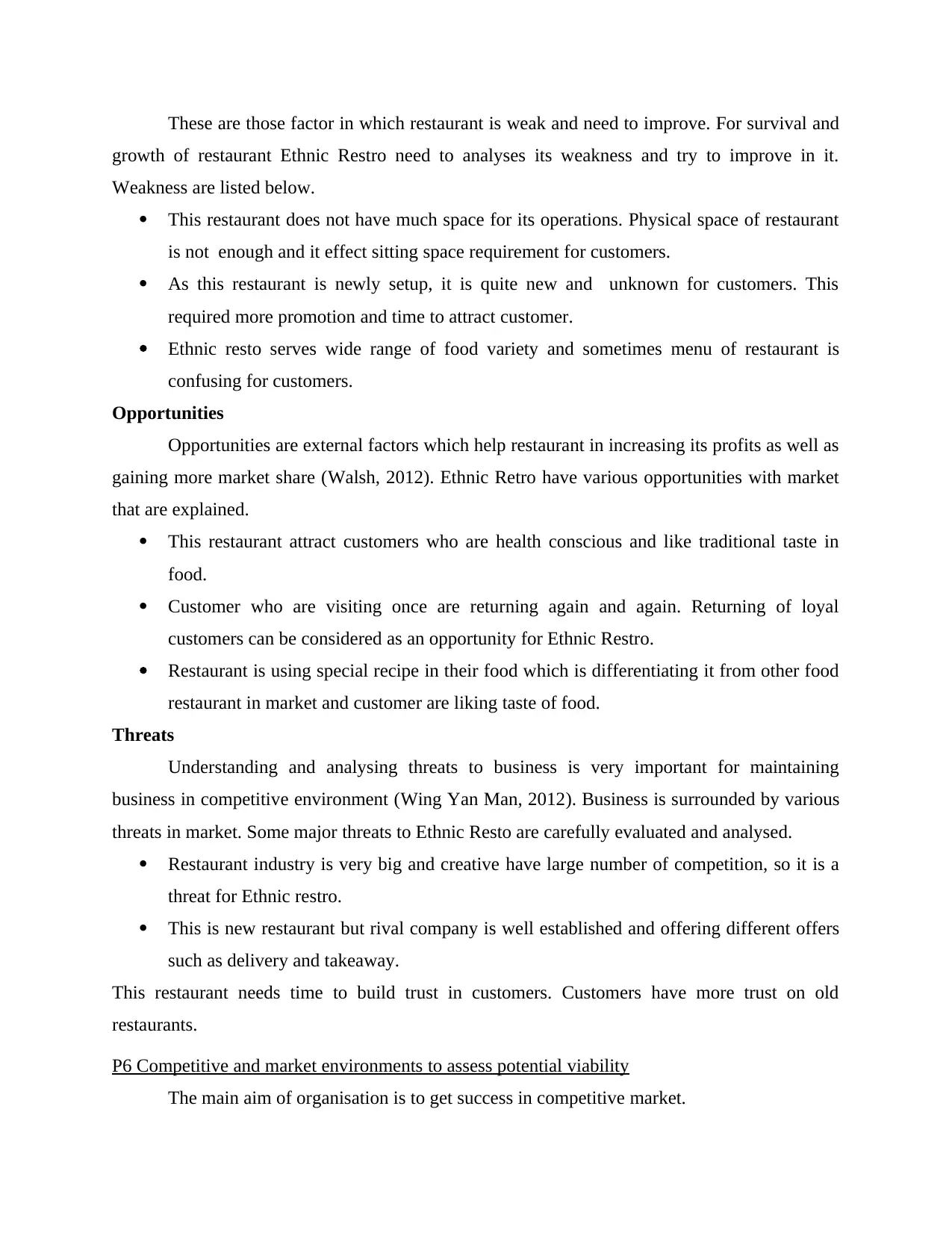
These are those factor in which restaurant is weak and need to improve. For survival and
growth of restaurant Ethnic Restro need to analyses its weakness and try to improve in it.
Weakness are listed below.
This restaurant does not have much space for its operations. Physical space of restaurant
is not enough and it effect sitting space requirement for customers.
As this restaurant is newly setup, it is quite new and unknown for customers. This
required more promotion and time to attract customer.
Ethnic resto serves wide range of food variety and sometimes menu of restaurant is
confusing for customers.
Opportunities
Opportunities are external factors which help restaurant in increasing its profits as well as
gaining more market share (Walsh, 2012). Ethnic Retro have various opportunities with market
that are explained.
This restaurant attract customers who are health conscious and like traditional taste in
food.
Customer who are visiting once are returning again and again. Returning of loyal
customers can be considered as an opportunity for Ethnic Restro.
Restaurant is using special recipe in their food which is differentiating it from other food
restaurant in market and customer are liking taste of food.
Threats
Understanding and analysing threats to business is very important for maintaining
business in competitive environment (Wing Yan Man, 2012). Business is surrounded by various
threats in market. Some major threats to Ethnic Resto are carefully evaluated and analysed.
Restaurant industry is very big and creative have large number of competition, so it is a
threat for Ethnic restro.
This is new restaurant but rival company is well established and offering different offers
such as delivery and takeaway.
This restaurant needs time to build trust in customers. Customers have more trust on old
restaurants.
P6 Competitive and market environments to assess potential viability
The main aim of organisation is to get success in competitive market.
growth of restaurant Ethnic Restro need to analyses its weakness and try to improve in it.
Weakness are listed below.
This restaurant does not have much space for its operations. Physical space of restaurant
is not enough and it effect sitting space requirement for customers.
As this restaurant is newly setup, it is quite new and unknown for customers. This
required more promotion and time to attract customer.
Ethnic resto serves wide range of food variety and sometimes menu of restaurant is
confusing for customers.
Opportunities
Opportunities are external factors which help restaurant in increasing its profits as well as
gaining more market share (Walsh, 2012). Ethnic Retro have various opportunities with market
that are explained.
This restaurant attract customers who are health conscious and like traditional taste in
food.
Customer who are visiting once are returning again and again. Returning of loyal
customers can be considered as an opportunity for Ethnic Restro.
Restaurant is using special recipe in their food which is differentiating it from other food
restaurant in market and customer are liking taste of food.
Threats
Understanding and analysing threats to business is very important for maintaining
business in competitive environment (Wing Yan Man, 2012). Business is surrounded by various
threats in market. Some major threats to Ethnic Resto are carefully evaluated and analysed.
Restaurant industry is very big and creative have large number of competition, so it is a
threat for Ethnic restro.
This is new restaurant but rival company is well established and offering different offers
such as delivery and takeaway.
This restaurant needs time to build trust in customers. Customers have more trust on old
restaurants.
P6 Competitive and market environments to assess potential viability
The main aim of organisation is to get success in competitive market.
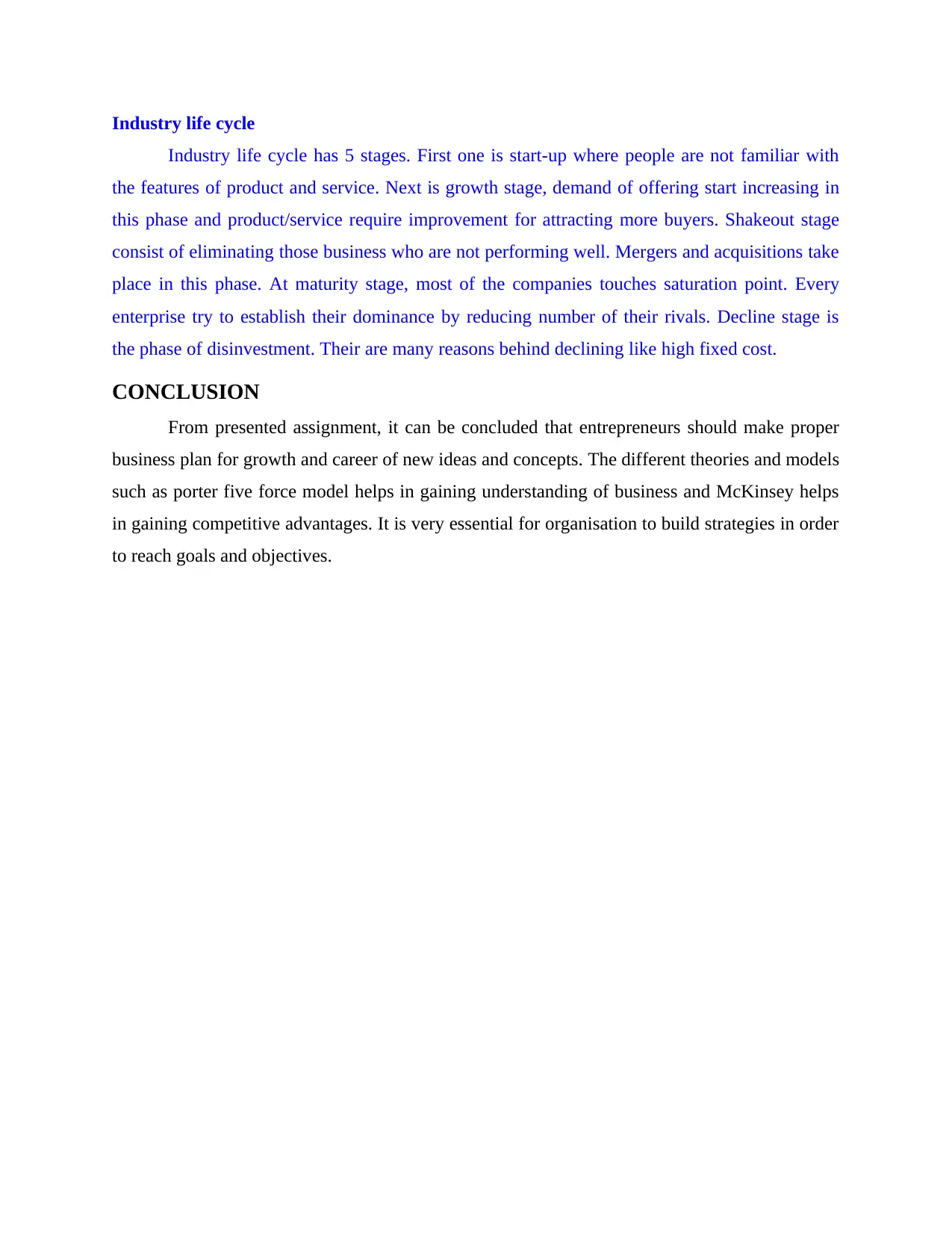
Industry life cycle
Industry life cycle has 5 stages. First one is start-up where people are not familiar with
the features of product and service. Next is growth stage, demand of offering start increasing in
this phase and product/service require improvement for attracting more buyers. Shakeout stage
consist of eliminating those business who are not performing well. Mergers and acquisitions take
place in this phase. At maturity stage, most of the companies touches saturation point. Every
enterprise try to establish their dominance by reducing number of their rivals. Decline stage is
the phase of disinvestment. Their are many reasons behind declining like high fixed cost.
CONCLUSION
From presented assignment, it can be concluded that entrepreneurs should make proper
business plan for growth and career of new ideas and concepts. The different theories and models
such as porter five force model helps in gaining understanding of business and McKinsey helps
in gaining competitive advantages. It is very essential for organisation to build strategies in order
to reach goals and objectives.
Industry life cycle has 5 stages. First one is start-up where people are not familiar with
the features of product and service. Next is growth stage, demand of offering start increasing in
this phase and product/service require improvement for attracting more buyers. Shakeout stage
consist of eliminating those business who are not performing well. Mergers and acquisitions take
place in this phase. At maturity stage, most of the companies touches saturation point. Every
enterprise try to establish their dominance by reducing number of their rivals. Decline stage is
the phase of disinvestment. Their are many reasons behind declining like high fixed cost.
CONCLUSION
From presented assignment, it can be concluded that entrepreneurs should make proper
business plan for growth and career of new ideas and concepts. The different theories and models
such as porter five force model helps in gaining understanding of business and McKinsey helps
in gaining competitive advantages. It is very essential for organisation to build strategies in order
to reach goals and objectives.
Secure Best Marks with AI Grader
Need help grading? Try our AI Grader for instant feedback on your assignments.
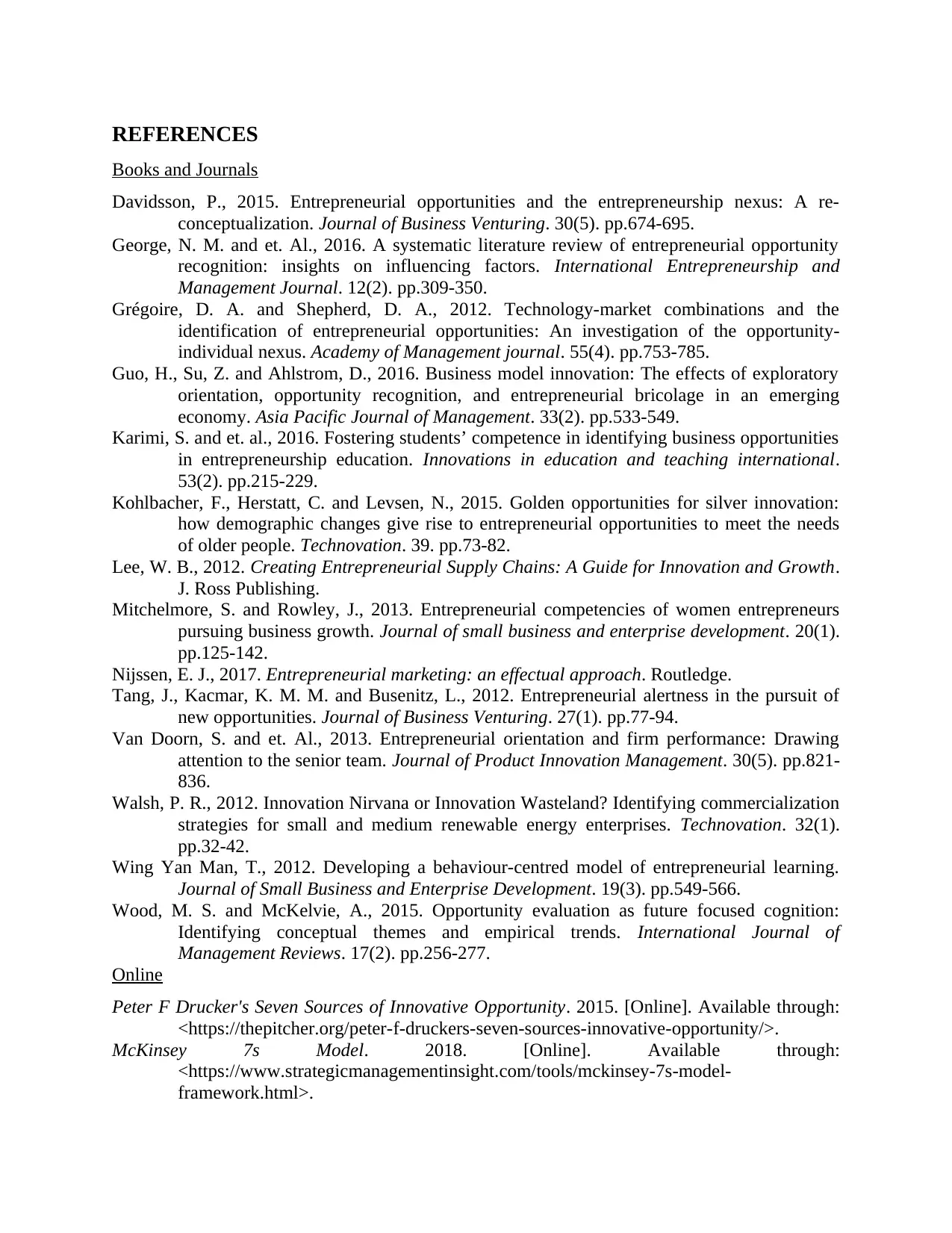
REFERENCES
Books and Journals
Davidsson, P., 2015. Entrepreneurial opportunities and the entrepreneurship nexus: A re-
conceptualization. Journal of Business Venturing. 30(5). pp.674-695.
George, N. M. and et. Al., 2016. A systematic literature review of entrepreneurial opportunity
recognition: insights on influencing factors. International Entrepreneurship and
Management Journal. 12(2). pp.309-350.
Grégoire, D. A. and Shepherd, D. A., 2012. Technology-market combinations and the
identification of entrepreneurial opportunities: An investigation of the opportunity-
individual nexus. Academy of Management journal. 55(4). pp.753-785.
Guo, H., Su, Z. and Ahlstrom, D., 2016. Business model innovation: The effects of exploratory
orientation, opportunity recognition, and entrepreneurial bricolage in an emerging
economy. Asia Pacific Journal of Management. 33(2). pp.533-549.
Karimi, S. and et. al., 2016. Fostering students’ competence in identifying business opportunities
in entrepreneurship education. Innovations in education and teaching international.
53(2). pp.215-229.
Kohlbacher, F., Herstatt, C. and Levsen, N., 2015. Golden opportunities for silver innovation:
how demographic changes give rise to entrepreneurial opportunities to meet the needs
of older people. Technovation. 39. pp.73-82.
Lee, W. B., 2012. Creating Entrepreneurial Supply Chains: A Guide for Innovation and Growth.
J. Ross Publishing.
Mitchelmore, S. and Rowley, J., 2013. Entrepreneurial competencies of women entrepreneurs
pursuing business growth. Journal of small business and enterprise development. 20(1).
pp.125-142.
Nijssen, E. J., 2017. Entrepreneurial marketing: an effectual approach. Routledge.
Tang, J., Kacmar, K. M. M. and Busenitz, L., 2012. Entrepreneurial alertness in the pursuit of
new opportunities. Journal of Business Venturing. 27(1). pp.77-94.
Van Doorn, S. and et. Al., 2013. Entrepreneurial orientation and firm performance: Drawing
attention to the senior team. Journal of Product Innovation Management. 30(5). pp.821-
836.
Walsh, P. R., 2012. Innovation Nirvana or Innovation Wasteland? Identifying commercialization
strategies for small and medium renewable energy enterprises. Technovation. 32(1).
pp.32-42.
Wing Yan Man, T., 2012. Developing a behaviour-centred model of entrepreneurial learning.
Journal of Small Business and Enterprise Development. 19(3). pp.549-566.
Wood, M. S. and McKelvie, A., 2015. Opportunity evaluation as future focused cognition:
Identifying conceptual themes and empirical trends. International Journal of
Management Reviews. 17(2). pp.256-277.
Online
Peter F Drucker's Seven Sources of Innovative Opportunity. 2015. [Online]. Available through:
<https://thepitcher.org/peter-f-druckers-seven-sources-innovative-opportunity/>.
McKinsey 7s Model. 2018. [Online]. Available through:
<https://www.strategicmanagementinsight.com/tools/mckinsey-7s-model-
framework.html>.
Books and Journals
Davidsson, P., 2015. Entrepreneurial opportunities and the entrepreneurship nexus: A re-
conceptualization. Journal of Business Venturing. 30(5). pp.674-695.
George, N. M. and et. Al., 2016. A systematic literature review of entrepreneurial opportunity
recognition: insights on influencing factors. International Entrepreneurship and
Management Journal. 12(2). pp.309-350.
Grégoire, D. A. and Shepherd, D. A., 2012. Technology-market combinations and the
identification of entrepreneurial opportunities: An investigation of the opportunity-
individual nexus. Academy of Management journal. 55(4). pp.753-785.
Guo, H., Su, Z. and Ahlstrom, D., 2016. Business model innovation: The effects of exploratory
orientation, opportunity recognition, and entrepreneurial bricolage in an emerging
economy. Asia Pacific Journal of Management. 33(2). pp.533-549.
Karimi, S. and et. al., 2016. Fostering students’ competence in identifying business opportunities
in entrepreneurship education. Innovations in education and teaching international.
53(2). pp.215-229.
Kohlbacher, F., Herstatt, C. and Levsen, N., 2015. Golden opportunities for silver innovation:
how demographic changes give rise to entrepreneurial opportunities to meet the needs
of older people. Technovation. 39. pp.73-82.
Lee, W. B., 2012. Creating Entrepreneurial Supply Chains: A Guide for Innovation and Growth.
J. Ross Publishing.
Mitchelmore, S. and Rowley, J., 2013. Entrepreneurial competencies of women entrepreneurs
pursuing business growth. Journal of small business and enterprise development. 20(1).
pp.125-142.
Nijssen, E. J., 2017. Entrepreneurial marketing: an effectual approach. Routledge.
Tang, J., Kacmar, K. M. M. and Busenitz, L., 2012. Entrepreneurial alertness in the pursuit of
new opportunities. Journal of Business Venturing. 27(1). pp.77-94.
Van Doorn, S. and et. Al., 2013. Entrepreneurial orientation and firm performance: Drawing
attention to the senior team. Journal of Product Innovation Management. 30(5). pp.821-
836.
Walsh, P. R., 2012. Innovation Nirvana or Innovation Wasteland? Identifying commercialization
strategies for small and medium renewable energy enterprises. Technovation. 32(1).
pp.32-42.
Wing Yan Man, T., 2012. Developing a behaviour-centred model of entrepreneurial learning.
Journal of Small Business and Enterprise Development. 19(3). pp.549-566.
Wood, M. S. and McKelvie, A., 2015. Opportunity evaluation as future focused cognition:
Identifying conceptual themes and empirical trends. International Journal of
Management Reviews. 17(2). pp.256-277.
Online
Peter F Drucker's Seven Sources of Innovative Opportunity. 2015. [Online]. Available through:
<https://thepitcher.org/peter-f-druckers-seven-sources-innovative-opportunity/>.
McKinsey 7s Model. 2018. [Online]. Available through:
<https://www.strategicmanagementinsight.com/tools/mckinsey-7s-model-
framework.html>.

Types of Research: Primary vs Secondary. 2019. [Online]. Available through:
<https://www.thehartford.com/business-playbook/in-depth/business-primary-second-
research>.
<https://www.thehartford.com/business-playbook/in-depth/business-primary-second-
research>.
1 out of 18
Related Documents
Your All-in-One AI-Powered Toolkit for Academic Success.
+13062052269
info@desklib.com
Available 24*7 on WhatsApp / Email
![[object Object]](/_next/static/media/star-bottom.7253800d.svg)
Unlock your academic potential
© 2024 | Zucol Services PVT LTD | All rights reserved.





